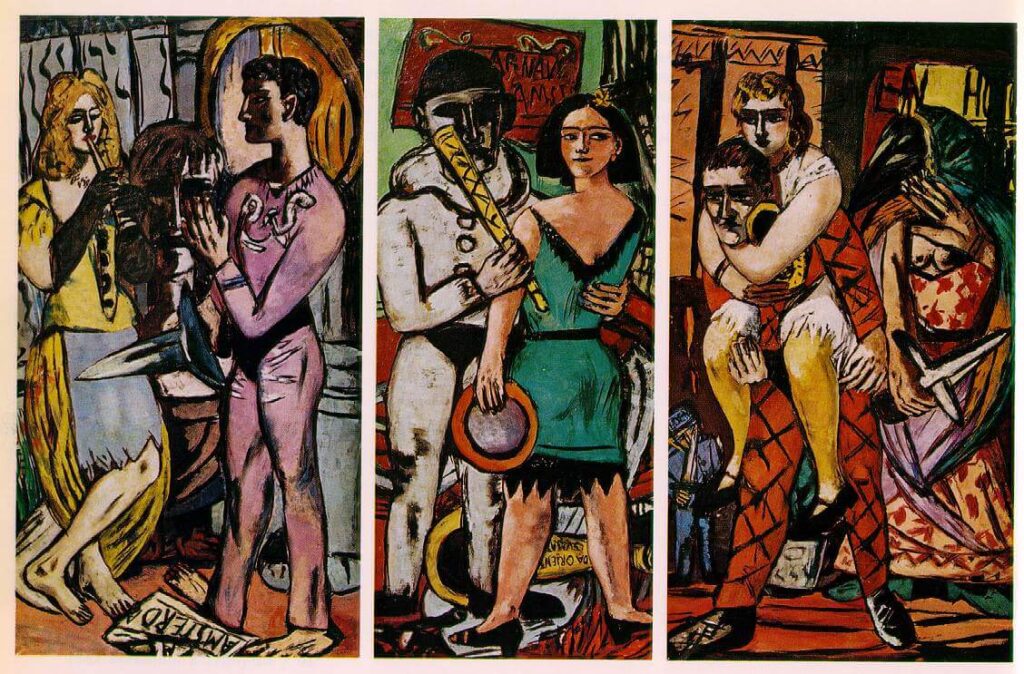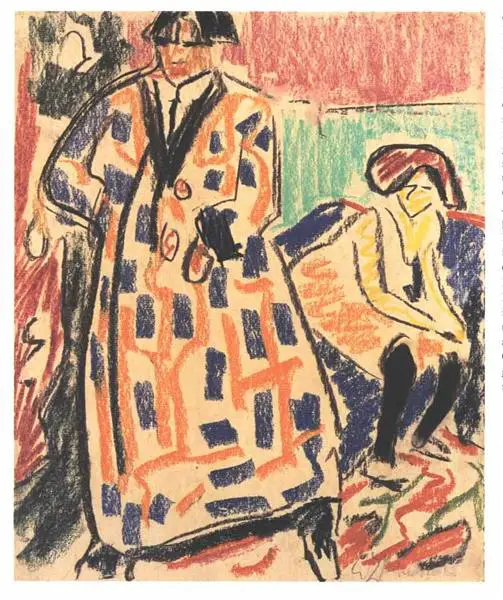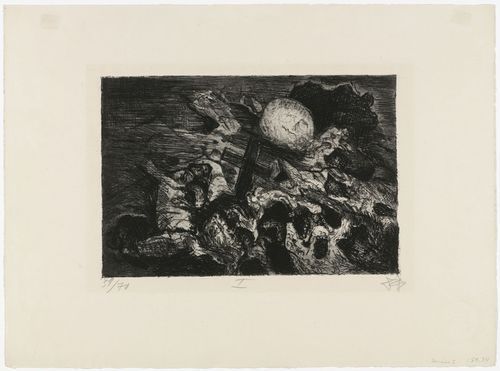German Expressionism is an art movement that is not very well known. It is an art movement that shows how politics and world events can and do affect art.
German Expressionism is an art movement that started in the early 20th century. The movement was a break from the art forms at the time as it was emotional, with bold colors and distorted forms. The German Expressionism movement was a reaction to the change in politics, society, and conflicts in Germany.
Table of Contents
- What Is The German Expressionism Art Movement?
- Important Artworks From The German Expressionism Movement
- German Expressionism’s Political Roots
- Frequently Asked Questions
- Related Questions
What Is The German Expressionism Art Movement?
German Expressionism was a movement that emerged in Germany in the early 20th century. It was characterized by its emotional intensity, bold colors, and distorted forms, and it was a reaction to the traditional art forms that were prevalent at the time.
While the movement is best known for its artistic contributions, it is essential to note that the political roots of German Expressionism are just as significant. This movement emerged during a time of great social and political upheaval in Germany, and many artists associated with the movement were deeply engaged with political issues.
Germany’s Political Turmoil From 1905 To 1933 Explored
The years of German Expressionism spanned from roughly 1905 to 1933. During this time, many artists were associated with the movement.
From 1905 to 1933, Germany witnessed a series of significant political events that shaped its history. Here are some major political events that occurred during this period:
- 1905: The First Moroccan Crisis – Germany’s involvement in the crisis highlighted its growing ambitions as a world power and strained relationships with other European nations.
- 1914-1918: World War I – Germany played a central role in this global conflict, which resulted in significant loss of life, economic devastation, and political upheaval. The war eventually led to the German Emperor’s abdication and the monarchy’s collapse.
- 1919: The Treaty of Versailles – As part of the peace settlement after World War I, Germany was forced to accept harsh terms, including territorial losses, disarmament, and financial reparations. This treaty created deep resentment and contributed to future political instability.
- 1919: The Weimar Republic – Following the abdication of the German Emperor, the Weimar Republic was established as a democratic government. It faced numerous challenges, including economic crises, political extremism, and social unrest.
- 1923: The Occupation of the Ruhr – In response to Germany’s failure to make reparation payments, France and Belgium occupied the industrial Ruhr region, leading to an economic crisis, hyperinflation, and political instability.
- 1923: The Beer Hall Putsch – Adolf Hitler and the National Socialist German Workers’ Party (NSDAP) attempted a coup in Munich, which was swiftly suppressed. Although it failed, it marked Hitler’s emergence as a prominent figure in German politics.
- 1924: The Dawes Plan – Introduced to address Germany’s economic crisis, the Dawes Plan provided loans and restructured reparation payments, stabilizing the German economy and easing financial burdens.
- 1929: The Great Depression – The global economic crisis had a profound impact on Germany, leading to widespread unemployment, poverty, and social unrest. This further polarized German society and fueled extremist ideologies.
- 1930: The Nazi Party’s Rise – The Nazi Party, under Adolf Hitler’s leadership, gained significant support in the Reichstag elections, becoming the second-largest party in Germany.
- 1933: Hitler’s Appointment as Chancellor – Following a series of political maneuvers, Adolf Hitler was appointed as German Chancellor in January 1933, marking the beginning of the Nazi regime. The Enabling Act, passed later that year, consolidated Hitler’s power and effectively ended democratic governance in Germany.
These significant events provide a glimpse into the political turmoil, social transformations, and the rise of extremist ideologies that occurred in Germany during the period from 1905 to 1933, ultimately leading to the collapse of the Weimar Republic and the establishment of Nazi rule.
These political and social changes also undoubtedly affected art and the German Expressionism art movement.
Important Artworks From The German Expressionism Movement
Throughout the German Expressionism movement, several important works of art were produced. In these works of art, you can see the political roots of the German Expressionism movement and how the day’s politics affected the German Expressionism movement.
The Prodigal Son (1922) by Max Beckmann
The Prodigal Son painting depicts a wealthy man returning home from war. He is dressed in a military uniform and is accompanied by a group of soldiers.

The painting is a commentary on the corruption and decadence of the German aristocracy during World War I.
Self-Portrait with Model (1913) by Ernst Ludwig Kirchner
The “Self-Portrait with Model” painting depicts Kirchner and a female model. It is a commentary on the sexual liberation that was taking place in Germany at the time.

The painting is notable for its frank depiction of sexuality and highlights the changing social mores of the time.
Street, Berlin (1913) by Ernst Ludwig Kirchner

The Street, Berlin painting depicts a busy street in Berlin. It is notable for its chaotic and frenzied composition, which highlights the energy and vitality of the city.
However, it also reflects the social and political tensions brewing in Germany at the time, as the industrialization and modernization of the city were accompanied by growing inequality and social unrest.
The War (1924) by Otto Dix

The War painting depicts a chaotic and nightmarish vision of war. It is notable for its graphic and gruesome depiction of violence and death, reflecting the horror and trauma soldiers experienced during World War I.
The painting is a powerful indictment of war and the systems that perpetuate it.
German Expressionism’s Political Roots
These works of art highlight the political roots of German Expressionism and how the movement engaged with the social and political issues of the time. Many of these works of art are powerful critiques of the government and the military during World War I, while others reflect on the changing social mores and growing inequality of the time.
These works of art reflect Germany’s political and social upheaval during the early 20th century, highlighting the importance of art as a social commentary and critique.
The political roots of German Expressionism are just as significant as their artistic contributions. This movement emerged during a time of great social and political upheaval in Germany, and many artists associated with the movement were deeply engaged with political issues.
German Expressionism was a transformative movement that profoundly impacted the world of art and politics, and its legacy continues to be felt today.
Anita Louise Art is dedicated to art education, great artists, and inspiring others to find and create their art. We love art that uplifts and inspires. #ArtToMakeYouSmile! #ArtToMakeYouHappy!
If you want to see any of my art, you can find out more by clicking here. If you are interested in what inspires me and my paintings, you can discover more by clicking here.
We have a free newsletter and would love you to be part of our community; you can subscribe to the newsletter by clicking here. If you have any questions, I would be happy to talk to you. You can reach me, Anita, by clicking here.
Subscribe to our Anita Louise Art YouTube Channel, filled with great videos and information by clicking here.
Join us for our podcast “5 Minutes With Art.” Spend just 5 minutes a week with us to discover and learn about great art and artists. You can find out more about our podcast by clicking here.
Frequently Asked Questions
Can I use oil paints with a palette knife?
Yes, oil paints can be effectively used with a palette knife.
What is a palette knife?
A palette knife is a tool with a blunt blade, often made of metal, used for mixing and applying paint.
Why would I use a palette knife instead of a brush?
Palette knives offer a unique way of applying paint, creating texture, and achieving distinct artistic effects that may be challenging to achieve with a brush.
What are the advantages of using a palette knife?
Palette knives allow for bold and textured brushwork, layering of thick paint, and the creation of unique surface effects. They also enable artists to work with a range of techniques, from controlled strokes to impasto applications.
Can I create smooth and detailed work with a palette knife?
While palette knives are better suited for creating texture and impasto effects, with practice, you can also achieve smoother and more detailed work by manipulating the paint with the knife’s edge.
What types of effects can I achieve with a palette knife?
Palette knives can be used to create various effects such as blending colors, scraping paint, applying thick impasto layers, creating texture, and achieving expressive, bold strokes.
Are there different types of palette knives?
Yes, there are various types of palette knives, including straight-edged knives, trowel-shaped knives, and knives with different sizes and shapes of blades. Each type offers unique possibilities for mark-making and texture creation.
Can I mix colors on the palette with a palette knife?
Absolutely! Palette knives are excellent tools for mixing colors on your palette, allowing you to blend pigments and create custom hues without using a brush.
Related Questions
What Was The Focus Of Renaissance Art?
The focus of Renaissance art was on the classics of Greek and Rome, humanist philosophy, and the study of the human figure. Realism was also an essential part of renaissance art. The great artists of the Renaissance also became great anatomists and studied human beings.
By clicking here, you can learn more by reading What Was The Focus Of Renaissance Art?.
What Is The Importance Of Art From The Renaissance Period?
Renaissance art is essential as it was a time of rebirth and discovery. Artists like Leonardo da Vinci, Michelangelo, and Raphael were at the forefront of that change, creation, and discovery. Renaissance art has influenced art and artists for many centuries and continues to influence artists today.
By clicking here, you can learn more by reading What Is The Importance Of Art From The Renaissance Period?.
21 Top Renaissance Artists And Their Works Of Art
When we speak of top Renaissance artists, we think of the trinity of artists like Leonardo da Vinci, Michelangelo, and Raphael. But besides these three artists, many other influential Renaissance artists remain essential.
By clicking here, you can learn more by reading 21 Top Renaissance Artists And Their Works of Art.

